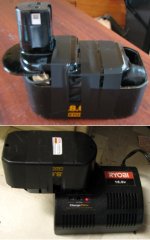xyster
10 MW
Yesterday while perusing my local Harborfreight store for a 18v nicad powertool pack to replace my old Ryobi pack that just died, I noticed Drillmaster 1.7ah Nicad packs on sale for $10.
http://www.harborfreight.com/cpi/ctaf/Category.taf?CategoryID=143&pricetype=
If like my Ryobi pack, they're sub-C's in a 14-S, 5-4-5 configuration. The Ryobi replacement costs $25 online. So I'm planning to pull the cells from this pack instead, swapping them into the Ryobi casing.
$10 per pack is $0.71 per cell -- significantly cheaper per AH than the $2.69 2.3ah sub-C nicad cells from all-battery et al:
http://www.all-battery.com/index.asp?PageAction=VIEWPROD&ProdID=418
An 8.5ah 36 volt, 30s4p pack for e-rides could be constructed for about $85 minus the charger(s). Of course each string would need to be charged separately, or separated with diodes, but still, this is significantly cheaper than even SLAs considering a 5-10 year service life. Some EV people have done the same thing with NiMH sub-C's.
http://www.harborfreight.com/cpi/ctaf/Category.taf?CategoryID=143&pricetype=
If like my Ryobi pack, they're sub-C's in a 14-S, 5-4-5 configuration. The Ryobi replacement costs $25 online. So I'm planning to pull the cells from this pack instead, swapping them into the Ryobi casing.
$10 per pack is $0.71 per cell -- significantly cheaper per AH than the $2.69 2.3ah sub-C nicad cells from all-battery et al:
http://www.all-battery.com/index.asp?PageAction=VIEWPROD&ProdID=418
An 8.5ah 36 volt, 30s4p pack for e-rides could be constructed for about $85 minus the charger(s). Of course each string would need to be charged separately, or separated with diodes, but still, this is significantly cheaper than even SLAs considering a 5-10 year service life. Some EV people have done the same thing with NiMH sub-C's.


